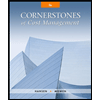
1.
Division will accept or reject the price of $340 if idle capacity is of 1,000-unit order.
Introduction: Transfer prices means the price charged on the product or service provided by on department of the company to another department of the company. Divisions are evaluated on the profit basis, or residual income price must be fixed for the transfer. Prices charged in these situations are referred as transfer prices.
2.
Financial advantage for the company if Q Divisions rejects the price of $340
Introduction: Transfer prices means the price charged on the product or service provided by on department of the company to another department of the company. Divisions are evaluated on the profit basis, or residual income price must be fixed for the transfer. Prices charged in these situations are referred as transfer prices.
3.
Financial advantage for the company if Q Divisions accepts the price of $340
Introduction: Transfer prices means the price charged on the product or service provided by on department of the company to another department of the company. Divisions are evaluated on the profit basis, or residual income price must be fixed for the transfer. Prices charged in these situations are referred as transfer prices.
4.
Conclusions drawn after the use of market price as transfer price in intra-company transactions.
Introduction: Transfer prices means the price charged on the product or service provided by on department of the company to another department of the company. Divisions are evaluated on the profit basis, or residual income price must be fixed for the transfer. Prices charged in these situations are referred as transfer prices.
Want to see the full answer?
Check out a sample textbook solution
Chapter 11A Solutions
MANAGERIAL ACCOUNTING FOR MANAGERS
- Can you demonstrate the accurate method for solving this financial accounting question?arrow_forwardI am searching for the correct answer to this general accounting problem with proper accounting rules.arrow_forwardOn November 10 of year 1, Javier purchased a building, including the land it was on, to assemble his new equipment. The total cost of the purchase was $1,200,000; $300,000 was allocated to the basis of the land, and the remaining $900,000 was allocated to the basis of the building. (Use MACRS Table 1, Table 2, Table 3, Table 4 and Table 5.) Note: Do not round intermediate calculations. Round your answers to the nearest whole dollar amount. Problem 10-51 Part e (Static) e. What would be the depreciation for 2024, 2025, and 2026 if the property were nonresidential property purchased and placed in service November 10, 2007 (assume the same original basis)?arrow_forward
- I am looking for the correct answer to this general accounting question with appropriate explanations.arrow_forwardCan you explain the process for solving this general accounting question accurately?arrow_forwardI need help solving this general accounting question with the proper methodology.arrow_forward
 Managerial Accounting: The Cornerstone of Busines...AccountingISBN:9781337115773Author:Maryanne M. Mowen, Don R. Hansen, Dan L. HeitgerPublisher:Cengage Learning
Managerial Accounting: The Cornerstone of Busines...AccountingISBN:9781337115773Author:Maryanne M. Mowen, Don R. Hansen, Dan L. HeitgerPublisher:Cengage Learning Cornerstones of Cost Management (Cornerstones Ser...AccountingISBN:9781305970663Author:Don R. Hansen, Maryanne M. MowenPublisher:Cengage Learning
Cornerstones of Cost Management (Cornerstones Ser...AccountingISBN:9781305970663Author:Don R. Hansen, Maryanne M. MowenPublisher:Cengage Learning

